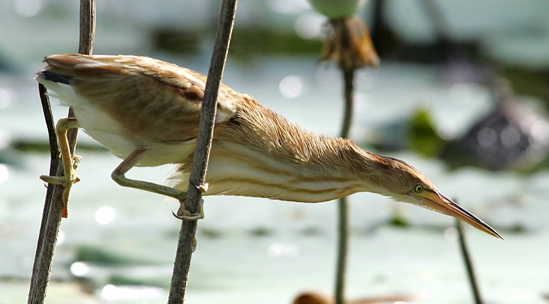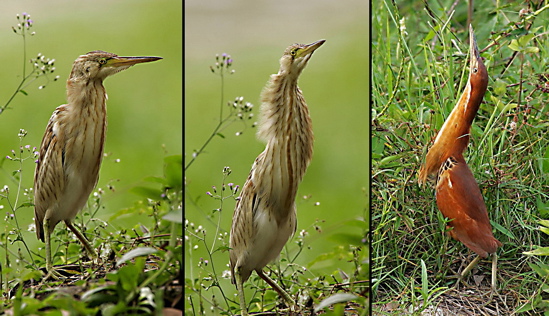Bitterns, members of the Arfeidae, are medium-size to large birds, usually with long legs, necks and bills.
The bittern eyes are placed on the sides of the head, giving the bird a monocular vision. However, unlike most other birds, the eyes are found low on the sides. This has the advantage of allowing it to look for food below in its normal foraging posture with its head stretched and the body and neck parallel to the ground (above). This so-called “crouched” posture makes it more cryptic, besides having the bill closer to the intended victim. At the same time the position of the eyes allows it to see ahead.
The bird needs to move its head from side to side as well as back and forward to improve its binocular vision. These movements also help to compensate for refraction, as the prey is in the water.
When the bittern is alarmed, it stretches its head and neck up, pointing its bill to the sky. This gives the bird a slim silhouette, blending it with the surrounding vegetation, usually water weeds like grasses and sedges. This is commonly known as the “Bittern-stance” and the bird can maintain the posture for several hours (above:middle and right).
 In this defensive posture, with its head pointing upwards, the position of the eyes allows it to have a clear vision of the sky above as well as in front.
In this defensive posture, with its head pointing upwards, the position of the eyes allows it to have a clear vision of the sky above as well as in front.
The images of the Yellow (Ixobrychus sinensis) (above: left and middle) and Cinnamon Bitterns (I. cinnamomeus) (above: right) show the birds in both postures and the positions of the eyes.
The image of the Yellow Bittern on the left by Heng Fook Hai clearly shows the excellent camouflage of the bird among the reeds.
When Meng and Melinda Chan observed the Yellow Bittern and captured the images, the bird was alarmed and in a defensive posture. Suddenly it flew off, after which a large raptor was seen flying overhead.
Images by Chan Yoke Meng except bottom image by Heng Fook Hai.










